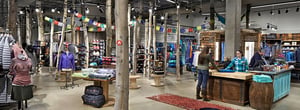Whether it’s to compete with online retailers or to bolster a component of a company‘s omni-channel strategy, leveraging the opportunities of physical space and location is critical to surviving (and thriving!) in a challenging retail climate.
We can all appreciate what online shopping has to offer; avoiding parking and long lines, off-hours access, saving time, and, best of all perhaps, shopping in pajamas! However, something critically human is missing in this mode: experience, relationship and community. Today’s consumers crave experiences and want to feel an authentic connection to their favorite brands and grounded in a like-minded community. These urges are what have given rise to the experiential retail movement.
For retailers to effectively embrace this movement and realize the potential of their physical space and location, the traditional design process must evolve. Retailers need to demand more from their designers and consultants to reach this next level of consumer engagement. When designing an experiential retail environment, the design team needs to peel away layers of assumption and dig deeper to create an experience that draws in customers and keeps them coming back.
Here are five steps to leverage the advantages of a brick and mortar location, aimed at taking experiential retail to the next level:
1. Authenticity
Define the retailer’s mission and find where this intersects with their customers’ core values. The intersection becomes the authentic connection point between a retailer and their customer. The authentic connection point will be the guide for all development decisions going forward, beginning with the choice of a brick and mortar location, and continuing to the design of the retail environment. Examples of authentic connection point location questions might include: “Does this location support the store’s activities in the community?” or “Does this location allow a connection to the outdoors?”
2. Partner
Based on the authentic connection point, consider partnering with other companies or service providers that enliven the retailer’s brand or provide complimentary services. For example, Target is testing a yogurt bar concept and Staples is partnering with Workbar to offer co-working space. Planning requirements will be impacted by this type of mutually beneficial partnering, so determining space needs prior to choosing a location is vital.
3. Emotion
A brick and mortar space allows retailers to connect with their customers on a deeper, emotional level by engaging all of the senses. Through the intentional use of form, light, materials, texture, scent and sound, experiential design can transport customers to a whole new state of mind. As part of the authentic connection point, think about the experiences customers would enjoy, particularly when using a retailer’s products, and create those experiences in the brick and mortar location. For example, Pirie Associates created an outdoor experience indoors by using bark-on tree poles in outdoor retailer, Denali’s Westfield Trumbull, Conn. mall location. In doing so, customers are momentarily transported out of the mall and into the place they love being most.
4. Connection
A retailer’s employees are people-extensions of a brand. How can the design of brick and mortar space support a retailer’s people-extensions? By creating opportunities for customers and employees to relate to one another through the brand’s authentic connection point. Imagine the spaces, product relationships, lighting and other environmental characteristics that would make the connection more useful and meaningful for the customer, and do that. Samsung has created an “unstore” so focused on experiencing the products with expert interaction with employees, that they do not sell anything in the brick and mortar location. Orders for products are placed in-store, are shipped directly to customers, and customers walk-out having developed a relationship to the product through the employee and the environment.
5. Community
When retailers find their authentic connection point with customers, many discover a passion to support this connection directly in their communities. For example, a retailer may consider hosting educational or cultural events, classes or trips, or getting involved in local causes that align with their mission. The decision to create community in this way can have impacts on location and space, and will guide lease decisions. This type of retailer engagement will build repeat, long-term engagement with customers, and offer a special kind of community that can only happen face to face.
As consumers demand and retailers move toward experience-driven environments, choices related to brick and mortar locations will require a higher degree of creativity. Real estate professionals who can help retailers analyze location and adjacencies to support a retailer’s authentic connection point will be ahead of the curve. The design team that follows the real estate deal will be on strong foundation to move into the design phase well situated to meet the retailer’s goals. Thriving in an increasingly competitive retail landscape takes imagination, thinking outside the box, and a willingness to work collaboratively to find solutions uniquely tailored to suit each company and their mission.




